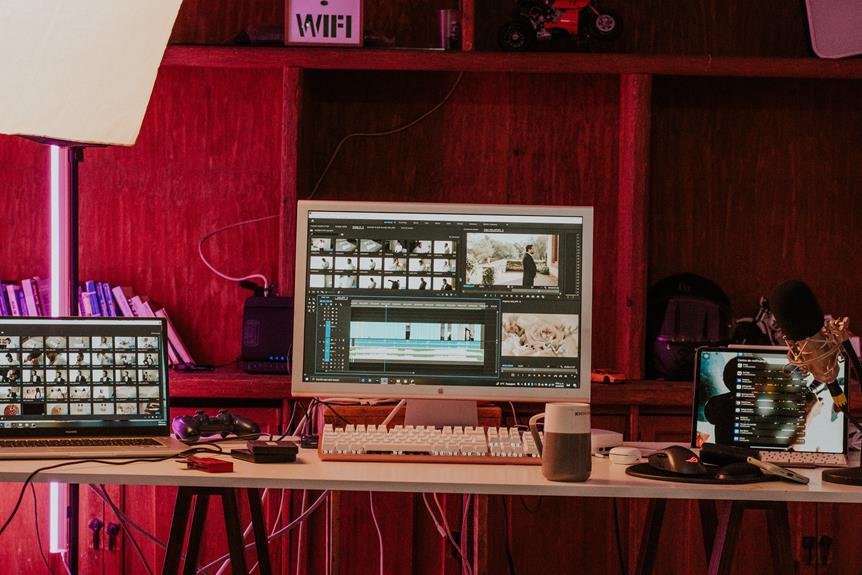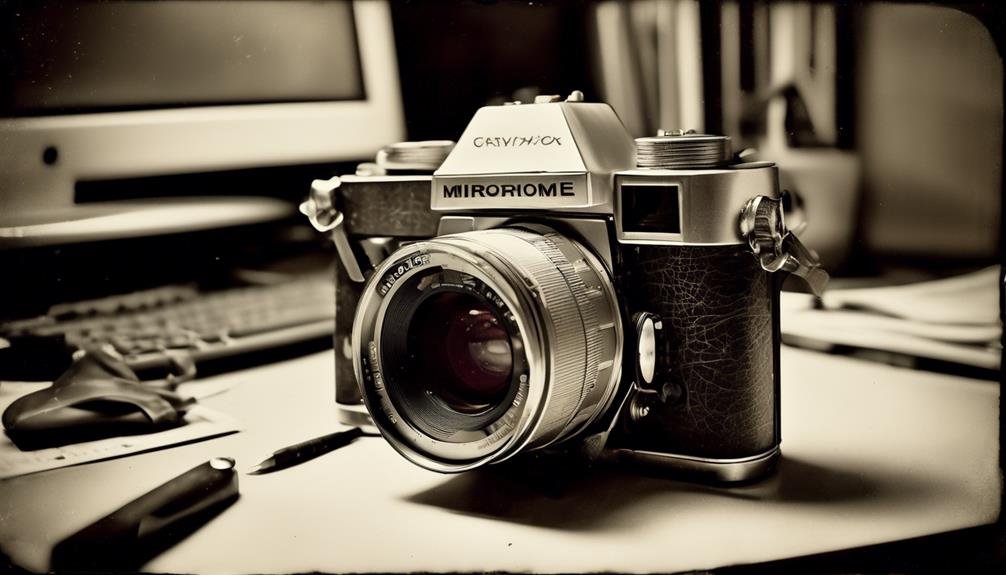
When it comes to editing software for mirrorless cameras, it's like having a top-notch chef's knife in the kitchen – you want the best tool for the job. There's no denying the power and potential of mirrorless cameras, and to truly unlock their capabilities, the right editing software is essential. As we navigate the vast landscape of available options, we can't help but wonder, what sets the best editing software apart from the rest? Well, the answer lies in a combination of key features, compatibility, speed, and advanced tools that not only enhance our images but also streamline our creative process.
Key Features to Look for in Editing Software

When choosing editing software for mirrorless cameras, it's essential to look for key features that enhance the editing process and optimize the quality of your photos. Non-destructive editing is a fundamental feature to consider. This allows you to make changes to your photos without altering the original image data, preserving the quality and enabling you to revert to the original image at any time. It's like having an undo button for every edit you make, ensuring that your photo quality remains intact throughout the editing process.
Another important feature to seek is batch processing. This capability saves time by allowing you to apply the same edits to multiple photos simultaneously. It's a huge time-saver, especially when you have a large number of photos from the same shoot that require similar adjustments. This feature streamlines the editing workflow, increasing efficiency and productivity.
Innovative editing software should offer these key features to ensure a seamless and efficient editing process while maintaining the highest quality standards for your photos.
Compatibility With Mirrorless Camera Brands
We found that editing software designed for mirrorless cameras varies in its compatibility with different camera brands. When choosing the best editing software for mirrorless, it's crucial to consider the compatibility with your specific camera brand. Here's a breakdown of how some popular editing software options stack up in terms of compatibility with major mirrorless camera brands:
| Canon | Nikon | Sony | Fujifilm | Panasonic | |
|---|---|---|---|---|---|
| Adobe | Supported | Supported | Supported | Supported | Supported |
| Capture One | Supported | Supported | Supported | Supported | Supported |
Canon and Nikon are two of the biggest players in the camera industry, and both Adobe and Capture One offer strong support for these brands. Sony and Fujifilm are renowned for their mirrorless systems, and both Adobe and Capture One provide excellent compatibility with these brands as well. When it comes to Panasonic and Olympus, Adobe and Capture One also offer support for these mirrorless camera brands. Understanding the compatibility of editing software with different mirrorless camera brands is essential for ensuring a seamless editing workflow.
Speed and Performance for High-Resolution Images

Understanding the compatibility of editing software with different mirrorless camera brands, we can now explore the impact of speed and performance on handling high-resolution images. When dealing with high-resolution images, fast processing becomes essential. The best editing software for mirrorless cameras should offer quick import, export, and rendering times to keep up with the demands of large image files. This ensures a smooth and efficient workflow, allowing photographers to focus on their creative process without being hindered by slow processing speeds.
Moreover, speed and performance greatly influence the overall image quality during editing. A software's ability to handle high-resolution images swiftly can impact the sharpness, clarity, and color accuracy of the final output. Additionally, fast processing contributes to a more responsive editing experience, enabling real-time adjustments and previews, which are crucial when working with detailed and intricate high-resolution images.
In essence, the best editing software for mirrorless cameras should not only deliver exceptional image quality but also provide fast processing capabilities to enhance the overall editing experience. By prioritizing speed and performance, photographers can truly harness the full potential of their high-resolution mirrorless camera images.
Advanced Editing Tools for Creative Flexibility
To achieve creative flexibility in editing, it's crucial to explore advanced tools that offer a wide range of options for enhancing and transforming mirrorless camera images. When choosing editing software, look for features that enable professional retouching, color grading, and the application of artistic filters. Here are some advanced editing tools that provide the creative freedom desired by photographers:
- Creative Effects: Seek software that offers a plethora of creative effects such as vintage, black and white, and infrared simulations. These effects can add depth and emotion to your images, elevating them to a new level of visual storytelling.
- Professional Retouching: Look for tools that allow for precise skin retouching, blemish removal, and the enhancement of portrait features. These features ensure that your subjects look their best while maintaining a natural appearance.
- Color Grading: Choose software with advanced color grading capabilities to manipulate the mood and tone of your images. This allows for the creation of visually stunning and cohesive collections of photographs.
Integration With Workflow and Organization Tools

Integration with workflow and organization tools streamlines the editing process and enhances efficiency for mirrorless camera photographers. The best editing software for mirrorless should seamlessly integrate with workflow automation and file management tools to ensure a smooth transition from capturing images to the final edited product. By connecting with workflow automation tools, photographers can automate repetitive tasks, such as importing photos, applying presets, and exporting final images, saving valuable time and effort. Furthermore, effective integration with file management tools allows for easy organization and retrieval of images, making it simple to locate specific photos for editing or sharing. This level of integration empowers photographers to focus more on their creative process and less on the technicalities of file handling and repetitive tasks.
When considering editing software for mirrorless cameras, it's essential to prioritize solutions that offer robust integration with workflow and organization tools. This ensures that photographers can optimize their editing process, maintain an efficient workflow, and ultimately spend more time capturing breathtaking images.
Frequently Asked Questions
Can Editing Software for Mirrorless Cameras Be Used for Video Editing as Well?
Yes, editing software for mirrorless cameras can be used for video editing as well. It enables color grading, special effects, multicam editing, and audio mixing, providing a comprehensive solution for both photo and video editing needs.
Is There a Limit to the Number of Devices the Editing Software Can Be Installed On?
Absolutely, there are compatibility limits when it comes to the number of devices you can install the editing software on. The installation process is straightforward, but it's crucial to be mindful of these limits.
Are There Any Additional Fees for Updates or New Features in the Editing Software?
Yes, there are cost implications for updates and new features in the editing software. The update frequency ensures we stay current with advancements. It's beneficial for our workflow and creativity.
Can the Editing Software Handle RAW Files From Multiple Mirrorless Camera Brands?
Yes, the editing software can handle raw files from multiple mirrorless camera brands with ease. Its compatibility and software capabilities ensure seamless editing across different brands. However, it may have some video editing limitations.
Does the Editing Software Offer Cloud Storage Options for Easy Access to Edited Photos From Different Devices?
Absolutely, our top editing software offers seamless cloud storage for easy access to your edited photos from any device. This feature not only ensures remote editing convenience but also guarantees the safety and accessibility of your precious work.
